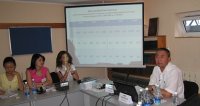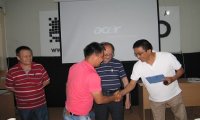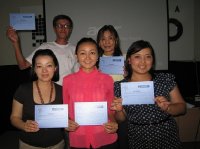17-07-2014, 09:23 Category: English, Media Diversity, News
 Intensive workshop was held on July 7-11, 2014 at
Bishkek under the supervision of the media trainers from Spain, Kazakhstan and
Kyrgyzstan, who have extensive experience in ethnic and inclusive journalism,
production of multimedia product.
Intensive workshop was held on July 7-11, 2014 at
Bishkek under the supervision of the media trainers from Spain, Kazakhstan and
Kyrgyzstan, who have extensive experience in ethnic and inclusive journalism,
production of multimedia product.
For five days journalists from 17 media of Kyrgyzstan mastered theoretical and practical methods of reports production and articles focused on ethnic diversity, improved their understanding of interethnic situation, and the new language policy of Kyrgyzstan, took a look at the terms used to cover such issues, learned how to use multimedia tools for create infographics, timelines, interactive photo and slideshows.
Zaiyrbek Ergeshov, an expert of the department of ethnic, religious policy and interaction with the civil society at the Kyrgyz Republic Presidential Administration, held a session on the importance of civil identity and said that the media must serve the interests of all ethnic groups living in the country.
"The state sees the role of journalists in the production of unbiased and objective material, in ensuring information security,” he emphasized.
During interactive discussions, the participants noted that when describing the lives, traditions, culture of ethnic groups they often substituted the notion of "diversity” with "differences”. Often material about the lives of ethnic groups is reported by the media focused on the peculiarities of such communities that distinguish them from the other part of society.
"The media should avoid negative message, not associate negative actions with ethnic, language, cultural identity of people,”Eran Fraenkel, a media trainer from Spain, who has extensive experience of working with the media on the Balkans, South and Central Asia, said.
 Fraenkel recommended local journalists to learn to
live in the diverse world and teach the same to their audience, to be tolerant,
to accept, understand and respect any signs of diversity. "[It is necessary] to
learn and find what is common for various communities,” he emphasized.
Fraenkel recommended local journalists to learn to
live in the diverse world and teach the same to their audience, to be tolerant,
to accept, understand and respect any signs of diversity. "[It is necessary] to
learn and find what is common for various communities,” he emphasized.
The participants agreed that the reporters did not need to focus on ethnic identity of the main characters of their stories. However, it is important to tell the audience about their perception of the world, education, contribution to the national development, occupation, hobbies. Besides, the media must indicate that various ethnic groups residing in Kyrgyzstan are the part of the majority, which accepts and respects them rather than isolates from them.
Shavkat Umarov, a producer of Yntymak Oblast Regional TV and Radio Company (ORTRK) of Osh, learned many new things during the training. They are the explanation of the components of the Concept of Advancing the Unity of Peoples of Kyrgyzstan and Interethnic Relations, according to which the journalist will make his reports from now on, and the international experience of diversity reporting.
"Now I know that interethnic situation reporting must be complex,” Umarov shared his impression. "The story should pay special attention to children since their upbringing plays important role in the prospects of interethnic world.”
Nurkyz Isakova, the director of Dostuk TV and Radio Company, said she acquired much knowledge she is going to share with her colleagues.
"We are not going to stop now; the topic is interesting and necessary,” Nurkyz said. "And we will be seeking more information in this regard, learn something new in the sphere of diversity reporting, since it is a critical mission of our radio station.”
 On the last day of
training, participants were working over their project, where they provided
their original ideas of ethnic, language and cultural diversity reporting.
On the last day of
training, participants were working over their project, where they provided
their original ideas of ethnic, language and cultural diversity reporting.
Independent board consisting of the representatives of the Soros Foundation Kyrgyzstan, and reliable local journalists reviewed 15 applications and selected 6 finalists eligible to receive grant support from the Freedom of Information Program of Soros Foundation – Kyrgyzstan. The winners will start implementing their ideas in mid-July 2014.
The following projects were found to be the best:
El TR TV Channel (Osh) – BizMyWe TV project is focused on the promotion of language and cultural diversity among young people. The main characters of talk shows and reports will be international families, representatives of other ethnic groups who have reached success in sport, young people who speak many languages.
Batken TV channel (Batken) – Yntymak TV project, "Unity” – will promote strengthening of concord among various ethnic groups, eliminate animosity, encourage cultural diversity in the region.
Yntymak ORTRK – "Menin Jashoom – My Life” TV program is intended for the younger generation. Its purpose is to teach kids and teenagers of various nationalities how to be tolerant, friendly, educated. The TV program will also have a radio version.
 Format.kg media portal
(Osh) – reports "Bizdin
Kaarmandar – Our heroes” are dedicated to famous and ordinary people,
representatives of various ethnic groups. Morality stories of their lives will
help people better learn each other, get the insight into their life, culture,
traditions, and become closer to them.
Format.kg media portal
(Osh) – reports "Bizdin
Kaarmandar – Our heroes” are dedicated to famous and ordinary people,
representatives of various ethnic groups. Morality stories of their lives will
help people better learn each other, get the insight into their life, culture,
traditions, and become closer to them.
Kabar Kyrgyz National News Agency (Bishkek) – the "Aimaktagy Etnikalyk Turmush – Ethnic Diversity in the Regions” TV project will tell about the life of ethnic groups in the regions focused on the issue of civil identity.
"Issyk Kul Wave” (Karakol) – "My Kyrgyzstan” radio project is focused on instilling in young people of Issyk Kul region the respect to the language, cultural, ethnic diversity and high level of civic consciousness.
The Encouraging Diversity through Media project is focused on content development, strengthening of constructive role of the media in interethnic dialog, improvement of professional skills of reporters when reporting on cultural, language, ethnic diversity issues.
The project of School of Peacemaking and Media technology is funded by the Freedom of Information Program of Soros Foundation – Kyrgyzstan.

The School of Peacemaking and Media Technology in Central Asia announces an annual competition among students from Kyrgyzstan, Kazakhstan,…

25 journalists and media workers from various regions of Kyrgyzstan have been trained to counter the propaganda of violent extremism and hate in…